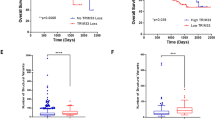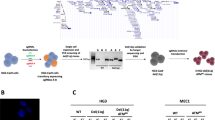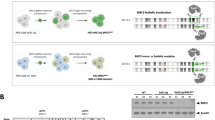Abstract
Recurrent cytogenetic abnormalities are the main hallmark of multiple myeloma (MM) and patients having 2 or more high-risk prognostic events are associated with extremely poor outcome. 17p13(del) and 1q21(gain) are critical and independent high-risk cytogenetic markers, however, the biological significance underlying the poor outcome in MM patients having co-occurrence of both these chromosomal aberrations has never been interrogated. Herein, we identified that patients harbouring concomitant 17p13(del) with 1q21(gain) demonstrated the worst prognosis as compared to patients with single- (either 17p13(del) or 1q21(gain)) and with no chromosomal events (WT for both chromosomal loci); and they are highly enriched for genomic instability (GI) signature. We discovered that the GI feature in the patients with concomitant 17p13(del)-1q21(gain) was recapitulating the biological properties of myeloma cells with co-existing p53-deficiency and NEIL1 mRNA-hyper-editing (associated with chromosome 17p and 1q, respectively) that have inherent DNA damage response (DDR) and persistent activation of Chk1 pathway. Importantly, this became a vulnerable point for therapeutic targeting whereby the cells with this co-abnormalities demonstrated hyper-sensitivity to siRNA- and pharmacological-mediated-Chk1 inhibition, as observed at both the in vitro and in vivo levels. Mechanistically, this was attributable to the synthetic lethal relationship between p53-NEIL1-Chk1 abnormalities. The Chk1 inhibitor (AZD7762) tested showed good synergism with standard-of-care myeloma drugs, velcade and melphalan, thus further reinforcing the translational potential of this therapeutic approach. In summary, combination of NEIL1-p53 abnormalities with an ensuing Chk1 activation could serve as an Achilles heel and predispose MM cells with co-existing 1q21(gain) and 17p13(del) to therapeutic vulnerability for Chk1 inhibition.
This is a preview of subscription content, access via your institution
Access options
Subscribe to this journal
Receive 50 print issues and online access
$259.00 per year
only $5.18 per issue
Buy this article
- Purchase on Springer Link
- Instant access to full article PDF
Prices may be subject to local taxes which are calculated during checkout







Similar content being viewed by others
References
Fonseca R, Bergsagel PL, Drach J, Shaughnessy J, Gutierrez N, Stewart AK, et al. International myeloma working group molecular classification of multiple myeloma: Spotlight review. Leukemia 2009;23:2210–21.
Bolli N, Biancon G, Moarii M, Gimondi S, Li Y, de Philippis C, et al. Analysis of the genomic landscape of multiple myeloma highlights novel prognostic markers and disease subgroups. Leukemia 2018;32:2604–16.
Walker BA, Mavrommatis K, Wardell CP, Ashby TC, Bauer M, Davies F, et al. A high-risk, double-Hit, group of newly diagnosed myeloma identified by genomic analysis. Leukemia 2019;33:159–70.
Shah V, Sherborne AL, Walker BA, Johnson DC, Boyle EM, Ellis S, et al. Prediction of outcome in newly diagnosed myeloma: a meta-analysis of the molecular profiles of 1905 trial patients. Leukemia 2018;32:102–10.
Boyd KD, Ross FM, Chiecchio L, Dagrada GP, Konn ZJ, Tapper WJ, et al. A novel prognostic model in myeloma based on co-segregating adverse FISH lesions and the ISS: Analysis of patients treated in the MRC Myeloma IX trial. Leukemia 2012;26:349–55.
Hao S, Lu X, Gong Z, Bassett RL, Hu S, Konoplev SN, et al. The survival impact of CKS1B gains or amplification is dependent on the background karyotype and TP53 deletion status in patients with myeloma. Mod Pathol. 2021;34:327–35.
Schmidt TM, Fonseca R, Usmani SZ. Chromosome 1q21 abnormalities in multiple myeloma. Blood Cancer J. 2021;11:83.
Stewart AK, Rajkumar SV, Dimopoulos MA, Masszi T, Spicka I, Oriol A, et al. Carfilzomib, lenalidomide, and dexamethasone for relapsed multiple myeloma. N. Engl J Med. 2015;372:142–52.
Jakubowiak AJ, Siegel DS, Martin T, Wang M, Vij R, Lonial S, et al. Treatment outcomes in patients with relapsed and refractory multiple myeloma and high-risk cytogenetics receiving single-agent carfilzomib in the PX-171-003-A1 study. Leukemia 2013;27:2351–6.
Avet-Loiseau H, Leleu X, Roussel M, Moreau P, Guerin-Charbonnel C, Caillot D, et al. Bortezomib plus dexamethasone induction improves outcome of patients with t(4;14) myeloma but not outcome of patients with del(17p). J Clin Oncol: Off J Am Soc Clin Oncol. 2010;28:4630–4.
Dimopoulos MA, Kastritis E, Christoulas D, Migkou M, Gavriatopoulou M, Gkotzamanidou M, et al. Treatment of patients with relapsed/refractory multiple myeloma with lenalidomide and dexamethasone with or without bortezomib: prospective evaluation of the impact of cytogenetic abnormalities and of previous therapies. Leukemia 2010;24:1769–78.
Chang H, Trieu Y, Qi X, Jiang NN, Xu W, Reece D. Impact of cytogenetics in patients with relapsed or refractory multiple myeloma treated with bortezomib: Adverse effect of 1q21 gains. Leuk Res. 2011;35:95–8.
Sonneveld P, Broijl A. Treatment of relapsed and refractory multiple myeloma. Haematologica 2016;101:396.
Neri P, Bahlis NJ. Genomic instability in multiple myeloma: Mechanisms and therapeutic implications. Expert Opin Biol Ther. 2013;13:S69–S82.
Agnelli L, Tassone P, Neri A. Molecular profiling of multiple myeloma: From gene expression analysis to next-generation sequencing. Expert Opin Biol Ther. 2013;13:S55–68. Suppl 1
Kumar SK. Targeted management strategies in multiple myeloma. Cancer J. 2019;25:59–64.
Chapman MA, Lawrence MS, Keats JJ, Cibulskis K, Sougnez C, Schinzel AC, et al. Initial genome sequencing and analysis of multiple myeloma. Nature 2011;471:467–72.
Herrero AB, Gutiérrez NC. Targeting ongoing DNA damage in multiple myeloma: Effects of DNA damage response inhibitors on plasma cell survival. Front Oncol. 2017;7:98.
Herrero AB, San Miguel J, Gutierrez NC. Deregulation of DNA double-strand break repair in multiple myeloma: Implications for genome stability. PloS One. 2015;10:e0121581.
Shammas MA, Shmookler Reis RJ, Koley H, Batchu RB, Li C, Munshi NC. Dysfunctional homologous recombination mediates genomic instability and progression in myeloma. Blood 2009;113:2290–7.
Yang CG, Garcia K, He C. Damage detection and base flipping in direct DNA alkylation repair. Chembiochem: Eur J Chem Biol. 2009;10:417–23.
Hayden PJ, Tewari P, Morris DW, Staines A, Crowley D, Nieters A, et al. Variation in DNA repair genes XRCC3, XRCC4, XRCC5 and susceptibility to myeloma. Hum Mol Genet. 2007;16:3117–27.
Sousa MM, Zub KA, Aas PA, Hanssen-Bauer A, Demirovic A, Sarno A, et al. An inverse switch in DNA base excision and strand break repair contributes to melphalan resistance in multiple myeloma cells. PloS One. 2013;8:e55493.
Teoh PJ, An O, Chung TH, Chooi JY, Toh SHM, Fan S, et al. Aberrant hyperediting of the myeloma transcriptome by ADAR1 confers oncogenicity and is a marker of poor prognosis. Blood 2018;132:1304–17.
Gkotzamanidou M, Terpos E, Bamia C, Munshi NC, Dimopoulos MA, Souliotis VL. DNA repair of myeloma plasma cells correlates with clinical outcome: The effect of the nonhomologous end-joining inhibitor SCR7. Blood 2016;128:1214.
Cottini F, Hideshima T, Suzuki R, Tai Y-T, Bianchini G, Richardson PG, et al. Synthetic lethal approaches exploiting DNA damage in aggressive myeloma. Cancer Discov. 2015;5:972.
Janz S, Zhan F, Sun F, Cheng Y, Pisano M, Yang Y, et al. Germline Risk Contribution to Genomic Instability in Multiple Myeloma. Front Genet. 2019;10:424.
Gu C, Wang W, Tang X, Xu T, Zhang Y, Guo M, et al. CHEK1 and circCHEK1_246aa evoke chromosomal instability and induce bone lesion formation in multiple myeloma. Mol Cancer. 2021;20:84.
Herrero AB, Rojas EA, Misiewicz-Krzeminska I, Krzeminski P, Gutiérrez NC. Molecular mechanisms of p53 deregulation in cancer: An overview in multiple myeloma. Int J Mol Sci. 2016;17:2003.
Bieging KT, Mello SS, Attardi LD. Unravelling mechanisms of p53-mediated tumour suppression. Nat Rev Cancer. 2014;14:359–70.
Eischen CM. Genome Stability Requires p53. Cold Spring Harb Perspect Med. 2016;6:a026096.
Teoh PJ, Chung TH, Sebastian S, Choo SN, Yan J, Ng SB, et al. p53 haploinsufficiency and functional abnormalities in multiple myeloma. Leukemia 2014;14:102.
Kawasumi M, Bradner JE, Tolliday N, Thibodeau R, Sloan H, Brummond KM, et al. Identification of ATR–Chk1 pathway inhibitors that selectively target p53-deficient cells without directly suppressing ATR catalytic activity. Cancer Res. 2014;74:7534.
Teoh PJ, Chung T-H, Chng PYZ, Toh SHM, Chng WJ. IL6R-STAT3-ADAR1 (P150) interplay promotes oncogenicity in multiple myeloma with 1q21 amplification. Haematologica. 2020;105:1391–404.
Lazzari E, Mondala PK, Santos ND, Miller AC, Pineda G, Jiang Q, et al. Alu-dependent RNA editing of GLI1 promotes malignant regeneration in multiple myeloma. Nat Commun. 2017;8:1922.
Teoh PJ, Koh MY, Chng WJ. ADARs, RNA editing and more in hematological malignancies. Leukemia 2021;35:346–59.
Rundle S, Bradbury A, Drew Y, Curtin NJ. Targeting the ATR-CHK1 axis in cancer therapy. Cancers (Basel). 2017;9:41.
Qiu Z, Oleinick NL, Zhang J. ATR/CHK1 inhibitors and cancer therapy. Radiother Oncol. 2018;126:450–64.
Zabludoff SD, Deng C, Grondine MR, Sheehy AM, Ashwell S, Caleb BL, et al. AZD7762, a novel checkpoint kinase inhibitor, drives checkpoint abrogation and potentiates DNA-targeted therapies. Mol Cancer Therapeutics. 2008;7:2955–66.
Landau HJ, McNeely SC, Nair JS, Comenzo RL, Asai T, Friedman H, et al. The checkpoint kinase inhibitor AZD7762 potentiates chemotherapy-induced apoptosis of p53-mutated multiple myeloma cells. Mol Cancer Therapeutics. 2012;11:1781–8.
Tembhare P, Yuan C, Korde N, Maric I, Landgren O. Antigenic drift in relapsed extramedullary multiple myeloma: Plasma cells without CD38 expression. Leuk Lymphoma. 2012;53:721–4.
Ma Z, Yao G, Zhou B, Fan Y, Gao S, Feng X. The Chk1 inhibitor AZD7762 sensitises p53 mutant breast cancer cells to radiation in vitro and in vivo. Mol Med Rep. 2012;6:897–903.
Muller FL, Colla S, Aquilanti E, Manzo VE, Genovese G, Lee J, et al. Passenger deletions generate therapeutic vulnerabilities in cancer. Nature 2012;488:337–42.
Chung T-H, Mulligan G, Fonseca R, Chng WJ. A novel measure of chromosome instability can account for prognostic difference in multiple myeloma. PloS One. 2013;8:e66361.
Chibon F, Lagarde P, Salas S, Perot G, Brouste V, Tirode F, et al. Validated prediction of clinical outcome in sarcomas and multiple types of cancer on the basis of a gene expression signature related to genome complexity. Nat Med. 2010;16:781–7.
Carter SL, Eklund AC, Kohane IS, Harris LN, Szallasi Z. A signature of chromosomal instability inferred from gene expression profiles predicts clinical outcome in multiple human cancers. Nat Genet. 2006;38:1043–8.
Chin SF, Teschendorff AE, Marioni JC, Wang Y, Barbosa-Morais NL, Thorne NP, et al. High-resolution aCGH and expression profiling identifies a novel genomic subtype of ER negative breast cancer. Genome Biol. 2007;8:R215.
Gourzones-Dmitriev C, Kassambara A, Sahota S, Rème T, Moreaux J, Bourquard P, et al. DNA repair pathways in human multiple myeloma: Role in oncogenesis and potential targets for treatment. Cell Cycle. 2013;12:2760–73.
Ray A, Ravillah D, Das DS, Song Y, Nordström E, Gullbo J, et al. A novel alkylating agent Melflufen induces irreversible DNA damage and cytotoxicity in multiple myeloma cells. Br J Haematol. 2016;174:397–409.
Neri P, Ren L, Gratton K, Stebner E, Johnson J, Klimowicz A, et al. Bortezomib-induced “BRCAness” sensitizes multiple myeloma cells to PARP inhibitors. Blood 2011;118:6368–79.
Chng WJ, Huang GF, Chung TH, Ng SB, Gonzalez-Paz N, Troska-Price T, et al. Clinical and biological implications of MYC activation: a common difference between MGUS and newly diagnosed multiple myeloma. Leukemia 2011;25:1026–35.
Acknowledgements
This study was funded by Tier 2 grant provided by the Ministry of Education of Singapore (MOE2019-T2-1-083) and NMRC OF-YIRG grant (NMRC/OFYIRG/032/2017-00). We would like to thank Pamela Chng for helping out with tissue culture and functional assays, Y.F. Goh, J.Q. Thng and W.N. Fam for helping with the processing and isolation of normal CD138 + plasma cells from healthy volunteers’ samples and M.Y. Koh for assisting in lentivirus work.
Author information
Authors and Affiliations
Contributions
PJT designed the study and performed all the wet experiments, analysed and interpreted data, and was entirely involved in the manuscript preparation, from drafting, editing to final submission. OA, THC, and HY were involved in bioinformatics analyses of MM datasets. TSV, AR, and VT contributed to the in vivo mouse work. MMH and ADJ performed IF on patient TMA, imaging, and data analysis. SHMT helped with the wet experiments and processing of primary patient samples. WW and MCC were the clinicians who performed hip surgeries on the healthy volunteers and harvested the bone marrow samples for CD138 + isolation. LC and MJF provided experimental advice, contributed vital reagents, and proofread the manuscript. WJC conceptualised the study, provided study direction, proofread and finalized the paper.
Corresponding author
Ethics declarations
Competing interests
The authors declare no competing interests.
Additional information
Publisher’s note Springer Nature remains neutral with regard to jurisdictional claims in published maps and institutional affiliations.
Supplementary information
Rights and permissions
About this article
Cite this article
Teoh, P.J., An, O., Chung, TH. et al. p53-NEIL1 co-abnormalities induce genomic instability and promote synthetic lethality with Chk1 inhibition in multiple myeloma having concomitant 17p13(del) and 1q21(gain). Oncogene 41, 2106–2121 (2022). https://doi.org/10.1038/s41388-022-02227-8
Received:
Revised:
Accepted:
Published:
Issue Date:
DOI: https://doi.org/10.1038/s41388-022-02227-8



